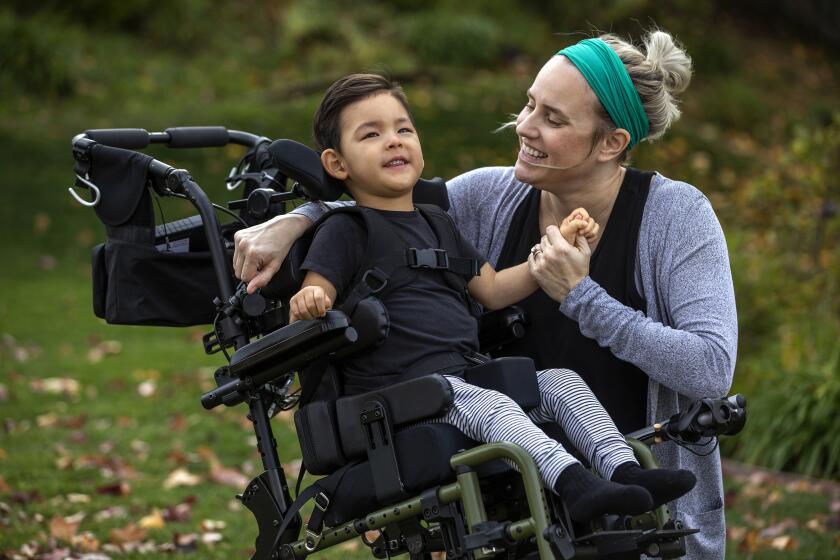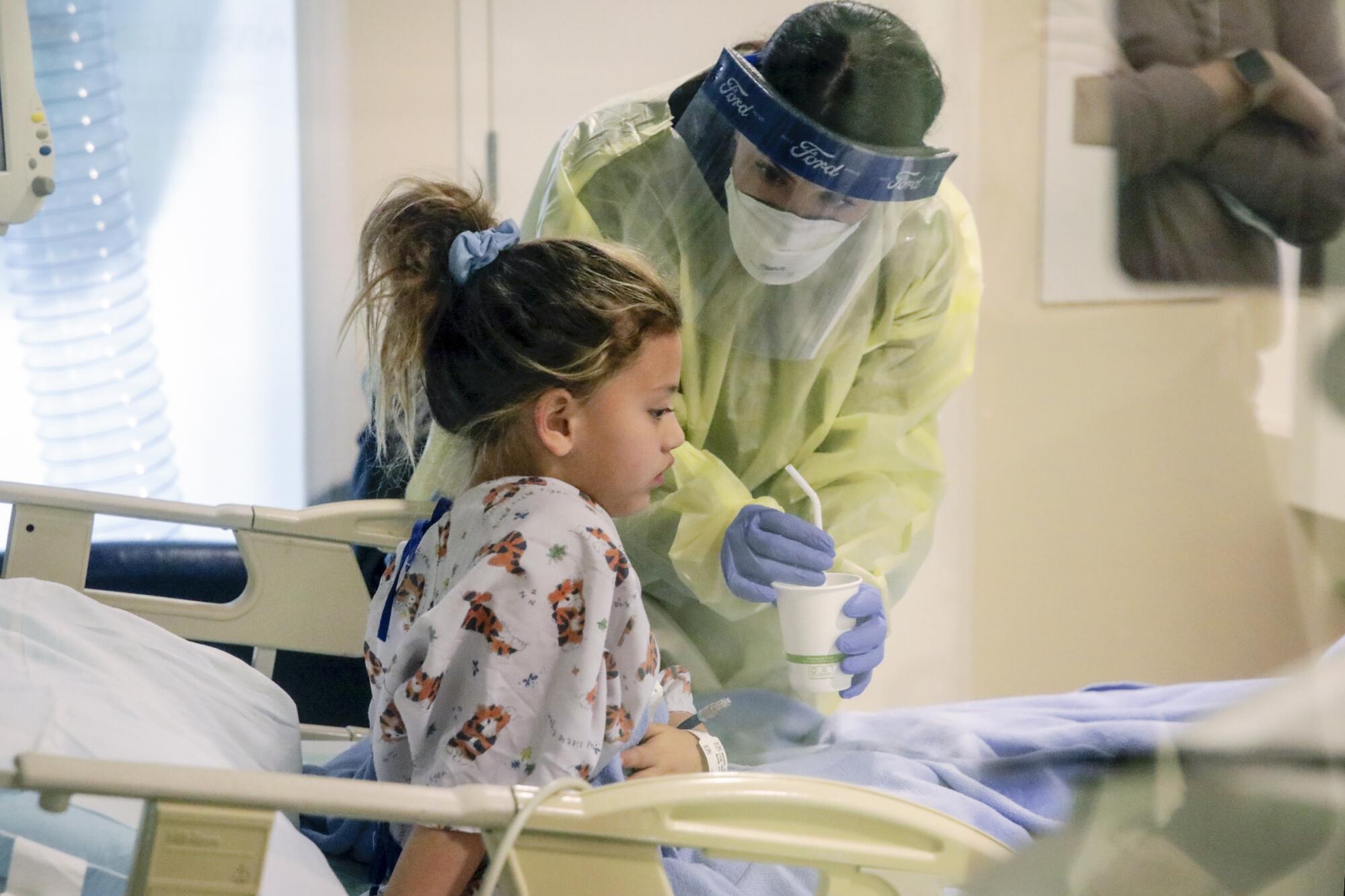
- Share via
SAN DIEGO — A unicorn stuffed animal kept the little girl company in the special infectious-disease unit at Rady Children’s Hospital.
The pink sign on Rachel Ward’s door warned that extra precautions were needed and that the door should remain closed. The 6-year-old could have one visitor in the room with her.
Rachel was one of 28 coronavirus-positive children in the San Diego hospital on a recent Wednesday. They ranged in age from 2 weeks to 17 years old.
The number of COVID-19 patients at Rady Children’s Hospital rose from a weekly average of five in the first week of December to 28 in the first week of January. For at least a year, there had been 30 rooms set up to accommodate COVID-19 patients, but the hospital recently set up an additional 15 because of the Omicron surge.
“This is definitely the highest, pure volume of patients we ever have seen with COVID positivity,” said Dr. Laurie Bernard Stover, director of inpatient services at Rady Children’s.
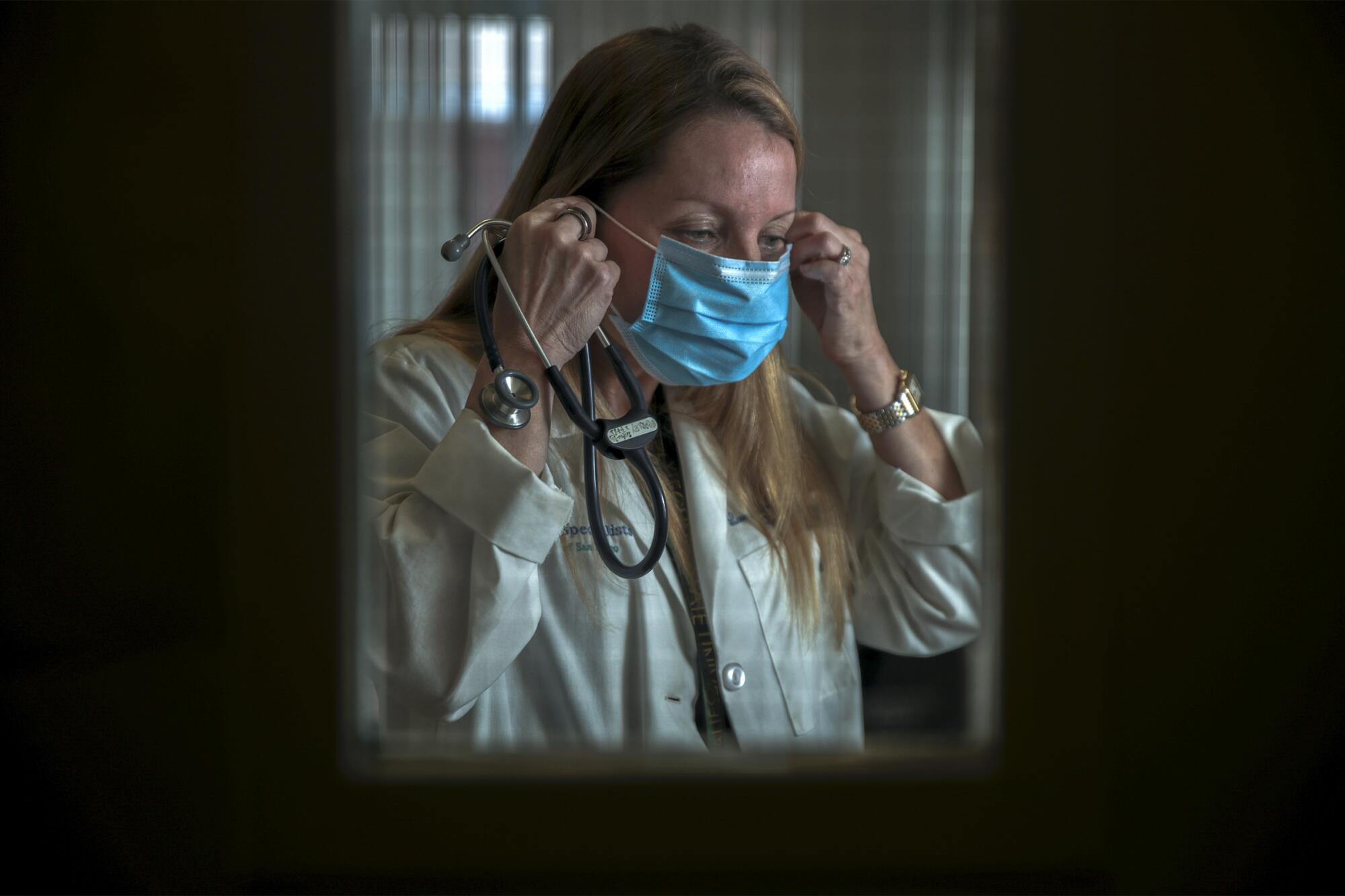
Young children — those younger than 5 — have been newly hospitalized with COVID-19 at higher rates than at any point in the pandemic, according to federal data. Health officials say the rising numbers among children are the result of the rapid spread of the Omicron variant, which is much more easily transmitted than earlier strains of the coronavirus.
The coronavirus surge is alarming for families with medically fragile children younger than 5 — the age group still not eligible for COVID-19 shots.
But Rachel was emblematic of a common occurrence amid the latest surge: She hadn’t come in for COVID-19. She landed here because of another ailment, and then ended up testing positive.
“Although many patients are COVID positive — so they’re placed in the unit under precautions — they’re here for a different reason,” Bernard Stover said. “COVID isn’t the primary reason for admission; it’s more of an incidental finding.”
While Omicron tends to be mild in children, doctors are worried about the possible long-term consequences of the virus, including the development of a relatively rare but serious condition known as multisystem inflammatory syndrome, or MIS-C.
With the rising number of children testing positive for the virus, doctors are once again urging those who can get vaccinated to do so. In San Diego County, around 67% of residents ages 12 to 17 are fully vaccinated. For 5- to 11-year-olds, that number stands at 23%, according to state data.
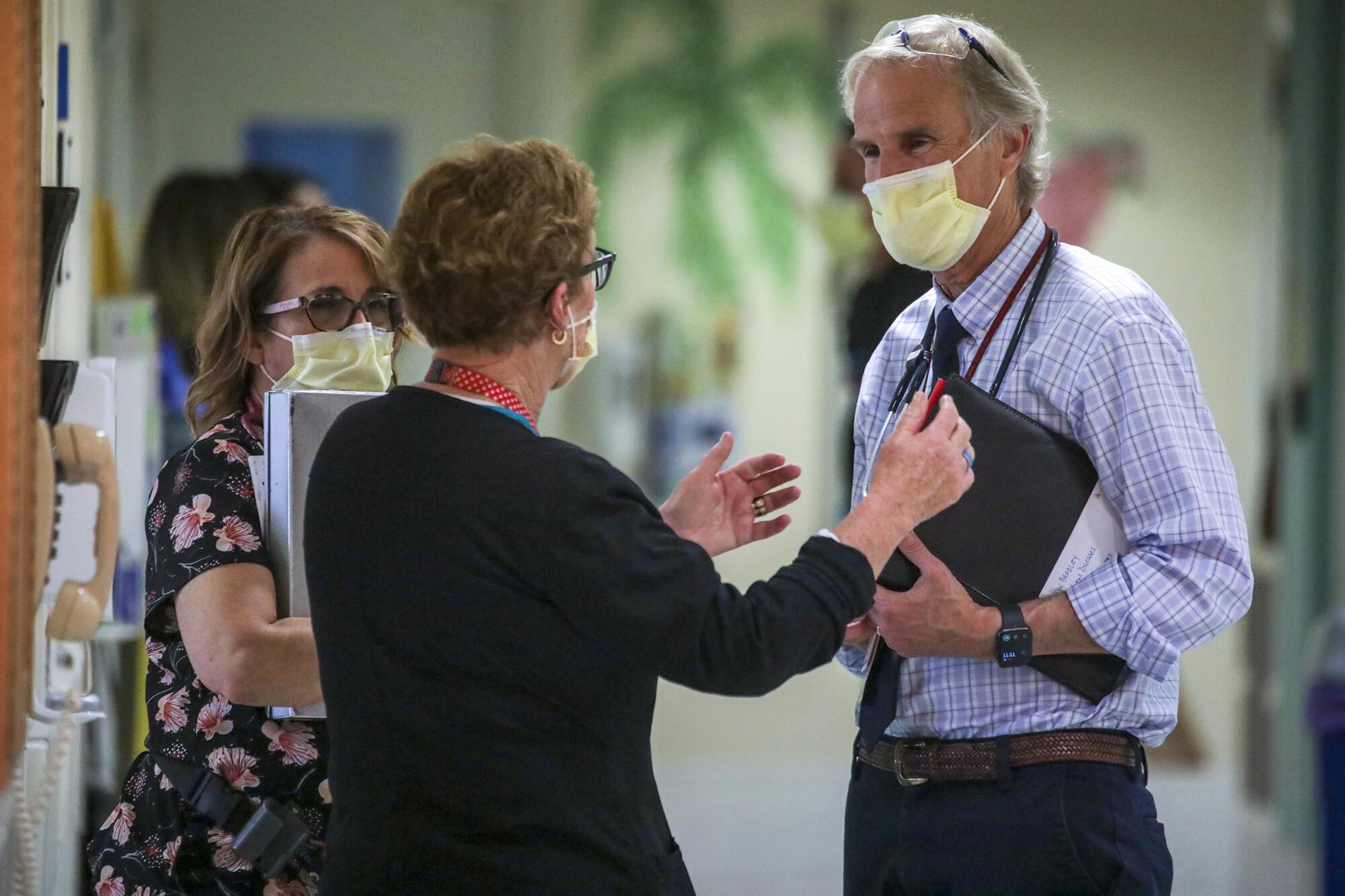
“People that say, ‘Oh, the vaccine’s no good, people are still getting infected.’ Well, that’s actually not the real benefit of the vaccine. It’s preventing hospitalizations and serious illness,” said Dr. John Bradley, the hospital’s medical director of the Division of Infectious Diseases. “So that hospitals don’t fill up with really sick kids or adults.”
The bill is the first to be introduced this year by a group of Democratic lawmakers pledging to strengthen vaccination laws and target misinformation amid the COVID-19 pandemic.
In the special infectious-disease unit on Medical North Pod C, the walls were painted with a smiling crab, an eel wearing red glasses and motivational words: “Dream higher than the sky and deeper than the ocean.”
A nearby poster featured video stills of Bernard Stover educating staff on how to put on and take off personal protective equipment — something now seemingly as routine to healthcare workers as putting on scrubs. (There’s been no known transmission of COVID-19 between children and healthcare workers, according to hospital officials.)
The unit was originally constructed as an Ebola unit, as Rady Children’s is a designated Ebola assessment center. When the pandemic began, it was converted to a COVID-19 unit.
“For Ebola, we were only going to set up a bed or two and for COVID it became clear really early that we would need a whole area with a significant number of beds potentially,” Bernard Stover said. “At the beginning, we didn’t really know — would it be a few patients? Would it be hundreds of patients?”
The number of coronavirus-positive patients in the unit has jumped in the last few months. In November, there were 10. In December, 69. From Jan. 1-18, there were 123.
Among those hospitalized with COVID-19 on Wednesday were babies with congenital disease, kids with underlying genetic disorders and others with cancer.
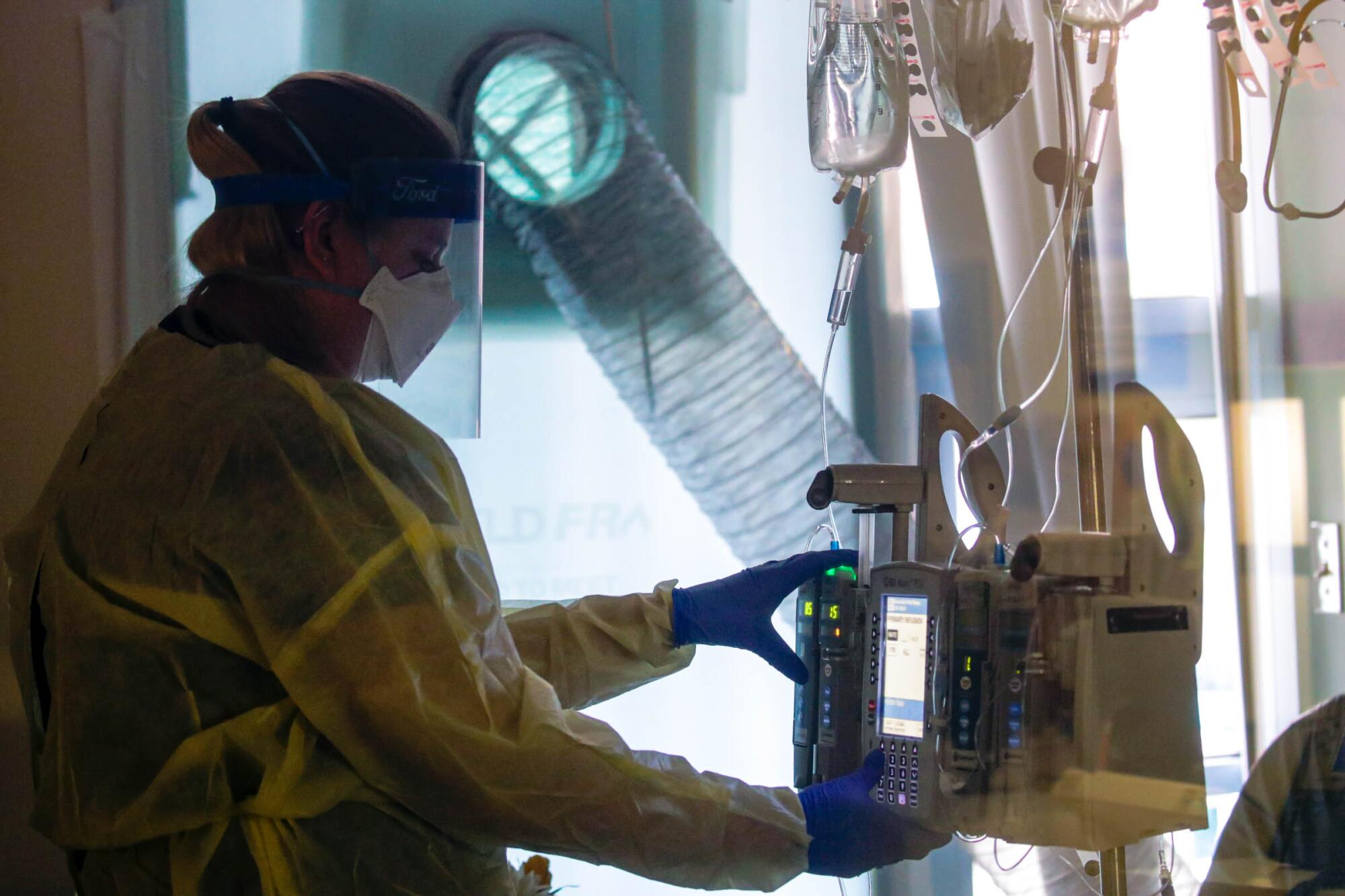
In the case of two children awaiting transplants, they were being treated with monoclonal antibodies — authorized for those 12 and older — to slow down the disease process and intravenous remdesivir to help clear it. They couldn’t get the transplant until they were coronavirus-negative.
Only those with the highest-risk underlying conditions are hospitalized for treatment — mainly severely immunodeficient children. The rest get hospitalized because they need support, such as oxygen and IV fluids.
There were eight children in the pediatric intensive care unit that day.
“We don’t want a single child to die, we don’t want a single child to suffer,” Bradley said. “What we do may be an overreaction, but ... no child here has died of either active infection or MIS-C and the team is very proud of that.”
That morning, Anne Katz, a registered nurse, helped with admissions, discharges and anything else the more than a dozen nurses on the floor might need — including help with changing a baby’s diaper.
Katz, who has worked at the hospital for 18 years, was on the unit during the first arrivals from Wuhan, China, in early 2020. She recalled U.S. marshals posted outside a baby’s room.
“That was when we knew nothing and everything was really scary,” she said.
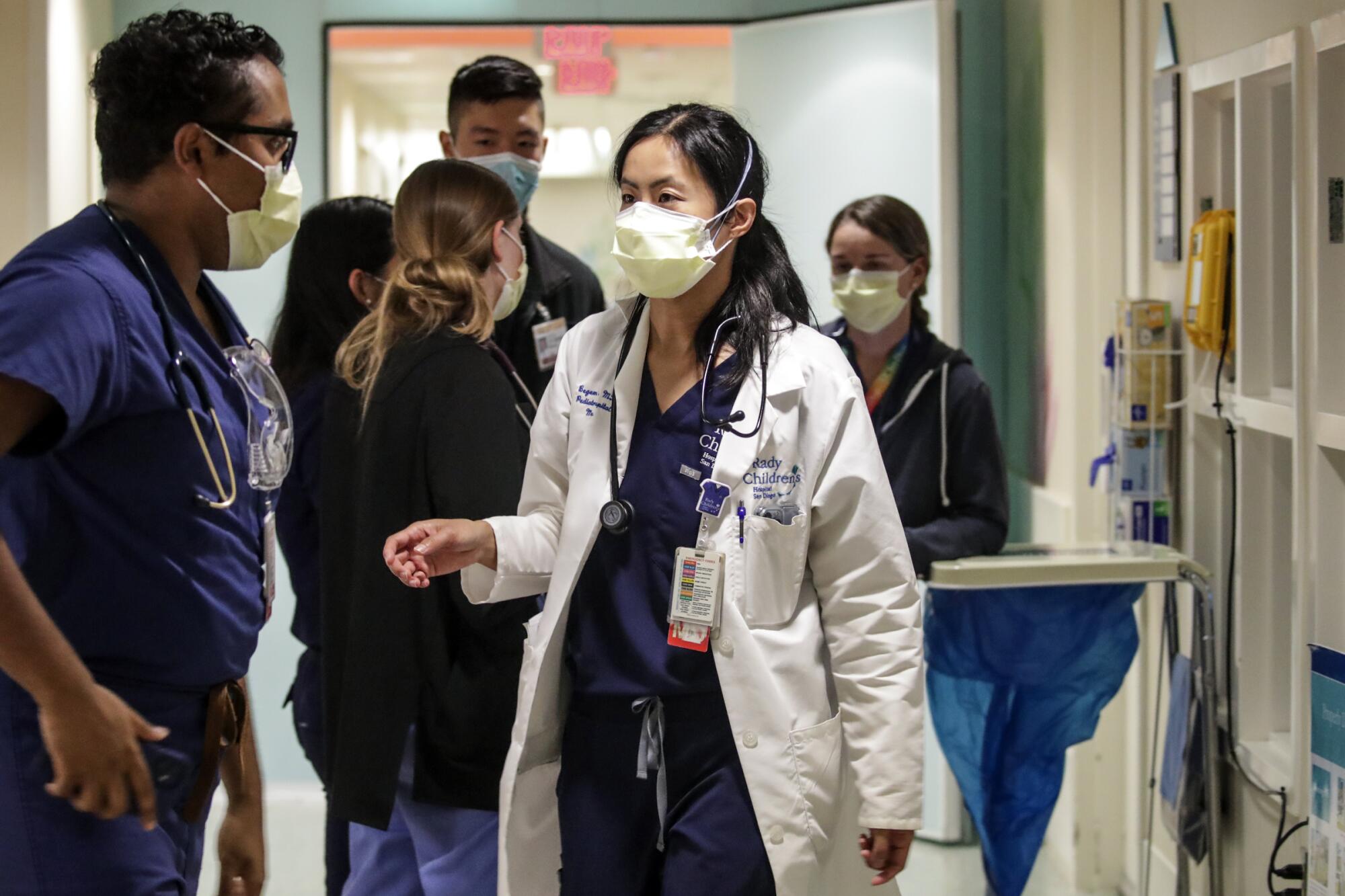
Although there are more pediatric hospitalizations during this surge, Katz pointed out that they were coming in with COVID-19 and not for COVID-19. One of her patients had stepped on a piece of glass and come to the hospital, where she tested positive.
“It’s an incidental finding because we’re swabbing everyone,” said Katz, who wore a “Be Kind” pin on her lanyard. “It’s not so much like they’re COVID-sick patients that we’re intubating left and right.”
When children are admitted, their length of stay is typically short. At times they are kept only overnight or for a few days to get oxygen or other treatment. Unlike adult COVID-19 units, a parent — or other bedside partners in care — is allowed in the room with the child. Chairs fold out into sleepers, allowing them to spend the night.
By 11 a.m., seven patients had already been discharged. Katz, who wore a pair of protective glasses on her head, waved at a mother as she pushed her baby in a stroller toward the elevators.
The baby had been admitted the night before with croup, an infection of the upper airway, caused by COVID-19. The hospital kept the girl overnight to make sure she didn’t have a problem when she got home. After treatment, which includes oral steroids, the baby was ready to head home.
Rachel, the 6-year old, would also be discharged later that day from North Side Pod C.
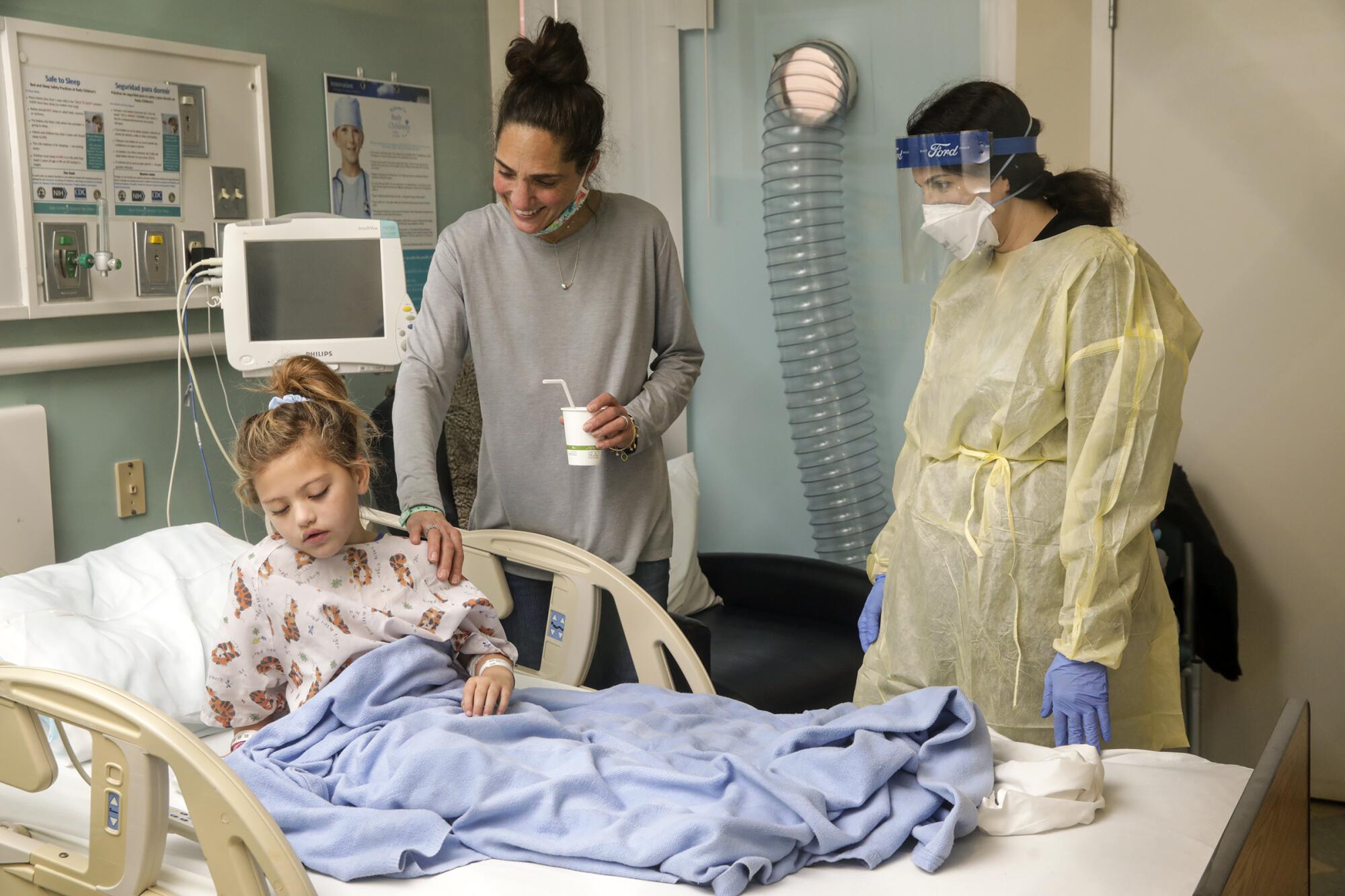
Inside the girl’s room, registered nurse Jessica Serven placed a stethoscope on her chest to listen to her breathing. Rachel, who wore a hospital gown decorated with sleeping tigers, then leaned forward to sip a laxative mixed with water from a paper cup.
Reached by phone, her father, Roger Ward, described the nightmare of hearing his daughter scream from her abdominal pain.
But he questioned the positive test result, saying that no one in the house had symptoms of the virus. He added that he didn’t believe the overall COVID-19 numbers or that it was that serious, explaining: “I watch Fox News.”
He also bristled at the idea of “forcing people to get a shot.”
“The best drug for this virus is your self-immunity, which is by getting it,” he said.
Physicians at Rady Children’s have heard similar remarks from other parents.
Bradley estimates that around three-quarters of parents regret not vaccinating their children, but others question whether the vaccine would have helped anything.
He cited new research from the Centers for Disease Control and Prevention that found that fully vaccinated children are at significantly lower risk of developing MIS-C.
There have been about 90 cases of MIS-C at Rady Children’s since the beginning of the pandemic. Symptoms of MIS-C can include a persistent fever, pain in the abdomen or neck, vomiting, diarrhea, rash, bloodshot eyes, low blood pressure and exhaustion. Inflammation of body parts, such as the heart, lungs, kidneys, brain, skin, eyes or gastrointestinal organs, is also a possible symptom.
The coronavirus can trigger a rare but serious inflammatory response that health officials are calling multi-system inflammatory syndrome in children, or MIS-C.
When Bradley has questioned parents about why their hospitalized child isn’t vaccinated, he’s been told, “Oh, it’s a little too soon,” or “We were planning to get it at some point.”
“The number of excuses is too long,” he said. “And none of them are really good.”
Times staff writer Emily Alpert Reyes contributed to this report.
More to Read
Sign up for Essential California
The most important California stories and recommendations in your inbox every morning.
You may occasionally receive promotional content from the Los Angeles Times.

